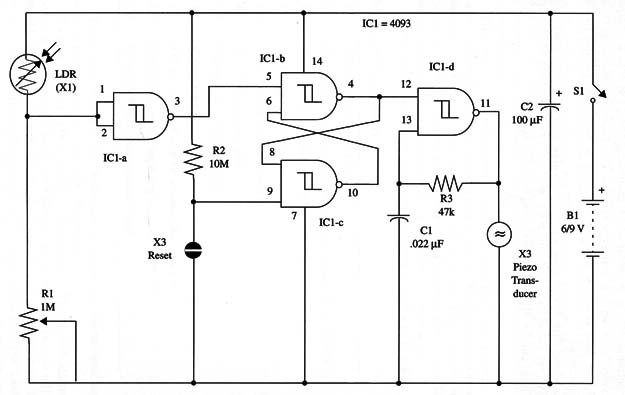The circuit is versatile and will work with almost any light-dependent resistor (LDR) or cadmium sulfide photocell such as the Radio Shack 27 6-1657 , with face diameters ranging from 1/8 to 1 inch.
The LDR and R1 form a potential divider that supplies gate drive to IC1-a.
When the circuit turns on, IC1-d is activated as an oscillator until the flip-flop formed by IC1-b and c is reset.
IC1-d acts as an audio oscillator, driving a piezoelectric transducer. If you need a more powerful audio output, you can use a power output stage with one or two transistors driving a loudspeaker, as shown in many other projects in this site.
A schematic diagram of the Bistable Light Alarm is shown in Fig. 1.

Transducer X1 is a piezo element such as the Radio Shack 27 3-07 3 or equivalent. You can also use as transducer a crystal earphone, but these elements will give less audio output than the original.
R1 adjusts sensitivity, and you can both use a potentiometer or trimmer pot to fit the intended application. Sensitivity is so high that the device can be turned on with light levels too small to be detected by the human eye.
Directional action is obtained by mounting the LDR into a opaque cardboard tube with a convergent lens. The LDR’s sensitive surface should be near the lens, focus. Sensitivity is also proportional to the lens diameter.
Changing this device into a dark-activated alarm is very easy: you simply transpose the LDR and R1 positions. The frequency of the au- dio signal can be altered by changing both C1 and R3.
IC1- 4093 CMOS integrated circuit
X1 - LDR or CdS photocell, Radio Shack 276-1657 (see text)
X2 -Piezoelectric transducer, Radio Shack 273-073 or equivalent
X3 - Touch sensor or momentary SPST switch
S1 - SPST slide or toggle switch
B1 - 6 V or 9 V, four AA cells or battery
R1 - 1,000,000 ohm potentiometer or trimmer potentiometer
R2 - 10,000,000 ohm, 1/4 W, 5% resistor
R3 - 47,000 ohm, 1/4 W, 5% resistor
C1 - 0.022 µF ceramic or metal film capacitor
C2 - 100 µF, 12 WVDC electrolytic capacitor



